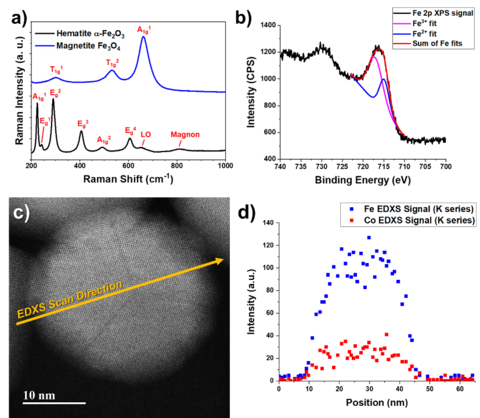Summary
This project comprises of two complimentary components: 1.) the controlled synthesis of selectively engineered magnetic nanoparticles (MNPs) in support of the ongoing Thermal MagIC metrology program and 2.) developing a suite of spectroscopic metrologies necessary to characterize the structure, composition, and magnetic behavior of MNPs, both in their ambient state and when dispersed in a medium or otherwise influenced by their environment.
Description

Figure 1: Electron micrographs of representative as-synthesized MNPs for thermometry. a,b) 10 nm Co0.6Fe2.4O4 c,d) Ferrimagnetic 85 nm Fe3O4 e,f) Bimagnetic 14 nm Co@CoO core-shell g) 7.5 nm single-crystalline Fe3O4 particles and h) 16 nm single-crystalline Fe3O4 MNPs, demonstrating the size control achievable using colloidal synthesis.
Nanomagnets by Design
Nanoparticles are an important subclass of low-dimensional magnetic materials displaying size-dependent magnetic behavior. The controllable magnetocrystalline anisotropy introduced at nanoscale size regimes (as low as 3 nms in diameter) allows for MNPs of ferro/ferrimagnetic materials to produce a tunable collective response to a dynamic applied magnetic field. This strong response to external applied fields, while simultaneously being dispersed in a medium, is the basis for employing these colloidal MNPs in applications such as imaging, sensing, drug delivery, and hyperthermia.
Magnetic nanothermometry, or Thermal MagIC, is an emerging application of MNPs. This metrology is based on the temperature-dependent nature of the spin interaction within each particle, and the ability of applied AC magnetic fields to penetrate through many materials to probe the magnetization therein as a function of position. However, commercially available MNPs display only modest magnetic thermosensitivity, especially near room temperature; this response must be strengthened as a prerequisite to practical remote volumetric nanothermometry. Carefully designed doped, core-shell, or multi-domain nanoparticles, with a strong AC magnetic response and selective control of thermosensitive temperature ranges arising from magnetic exchange interactions, represent a potential route to overcome these limitations. To these ends, in this part of the project we engineer magnetic nanoparticles specifically for room-temperature thermometry applications. Their synthesis relies on reproducible, easily scalable, solution chemistry routes and affords colloidal MNPs of controlled size, structure, and composition (Figure 1).
Optical Characterization of Magnetic Nanomaterials

Nanomagnets’ small size, sometimes as few as a dozen atoms across, leads to substantial difficulty in reliable scalable fabrication, compounded by challenges in the measurement of their inherent properties, especially when dispersed in another material. Spectroscopic characterization is a powerful set of techniques employing light to interrogate the physical, chemical, and magnetic characteristics of nanomagnets, both in an ambient environment and while being influenced by applied magnetic/electric fields, temperature, surrounding medium, or when used in next-generation electronic devices.
This part of the project aims to develop the rigorous measurements and methodologies needed for robust optical characterization of MNPs in all such environments. We employ spectroscopies ranging across much of the electromagnetic spectrum, from X-rays to infrared, to elucidate chemical and structural information of our nanomagnets (Figure 2). Under development is the ability to probe the magnetic behavior of MNPs by taking advantage of fundamental magneto-optical phenomena including Faraday rotation, Kerr effect, and magnetic circular dichroism. Optical microscopes, temperature-control cryostats, and spectrometers used in Optical Probes of 2D Magnetic Phenomena are also leveraged in this effort to investigate magnetic phenomena at high spatial resolution, emergent low-temperature physics, and dynamic magnetic behavior in solution. Advancing these in situ and in operando measurement capabilities facilitates the development and understanding of MNPs for applications in magnetic sensing, imaging, therapy, and quantum spin-based electronics.

